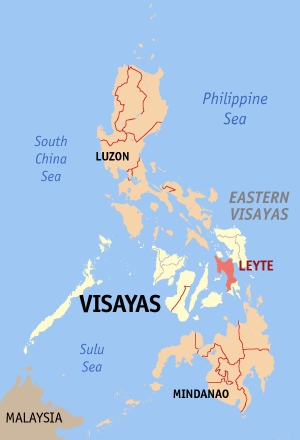LEYTE GULF, BATTLE OF (OCTOBER 1944)
| When | October 23–26, 1944 |
| Where | Leyte Gulf, a body of water immediately east of the island of Leyte in the Central Philippines, adjoining the Philippine Sea of the Pacific Ocean
|
| Who | American naval forces under Admiral William “Bull” Halsey, Jr. (1882–1959), commanding the U.S. Third Fleet, and Vice Admiral Thomas Kinkaid (1888–1972), commanding the U.S. Seventh Fleet (sometimes called “MacArthur′s Navy,” a reference to Gen. Douglas MacArthur, who was Allied Supreme Commander, Southwest Pacific Area), assisted by Royal Australian Navy Task Force 74. Together the Allies had at least 212 ships. Arrayed against them were the remnants of the Imperial Japanese Navy (IJN) consisting of some 60 ships in three strike forces: the Second Fleet, dubbed “Center Force,” under Vice Admiral Takeo Kurita (1889–1977), the “Southern Force” under Vice Admirals Shoji Nishimura (1889–1944) and Kiyohide Shima (1890–1973), and the sacrificial decoy “Northern Force” under Vice Admiral Jisaburo Ozawa (1886–1966). |
| Why | Allied campaigns from August 1942 to early 1944 had driven Japanese forces from many of their island bases in the south and central Pacific Ocean, while isolating many of their other bases. A few Japanese bases like Rota in the Marianas were bypassed, while neighboring Saipan and Tinian were captured. However, the considerable air power Japan had amassed in the Philippines was thought too dangerous to bypass by many high-ranking officers. A meeting between Gen. Douglas MacArthur, Adm. Chester Nimitz, and President Franklin D. Roosevelt confirmed the Philippines as a strategic target. Eventually it was decided that MacArthur′s forces would invade the island of Leyte and fulfill his 1942 promise to return to Philippine soil (wading through the surf when his landing craft stopped short of the beach). For their part, the Japanese launched Operation Sho-Go (Victory), designed to destroy the Allied amphibious forces invading Leyte. |
| What | On October 20, 1944, troops of Lt. Gen. Walter Krueger′s U.S. Sixth Army landed on Leyte Island. Over the next few days, Japanese naval forces counterattacked in the Battle of Leyte Gulf, which consisted of four separate engagements: the Battle of the Sibuyan Sea (October 24), the Battle of Surigao Strait and the Battle off Samar (October 25), and the Battle of Cape Engano (October 25–26). (The individual battles, separated by great distances, are counted together by virtue of their all being caused by Sho-Go). The Battle of Leyte Gulf is notable on multiple counts: it was the largest naval battle of World War II in terms of the area of engagement and in tonnage of warships sunk; it was the last naval battle between battleships in history (Battle of Surigao Strait); and it was the first naval battle in which Japanese aircraft successfully carried out organized kamikaze attacks (Battle off Samar). |
| Outcome | The Imperial Japanese Navy suffered its greatest loss of ships and crew ever—26 out of 60 front-line warships. The Americans had eight fleet carriers and eight light carriers with 1,500 planes against the Japanese single fleet carrier, Zuikaku—the only surviving carrier from the Pearl Harbor attack, which was sunk—and three light carriers. The U.S. lost the USS St. Lo, a light carrier. American casualties were about 3,000 dead to about 10,500 sailors and pilots for the Japanese. Of nine Japanese battleships, three were sunk, with a loss of no American battleship. The IJN’s failure to dislodge the Allied invaders from their beachheads in Leyte meant the inevitable loss of the Philippines. (Leyte was not completely in Allied hands until the end of December 1944.) This in turn meant that resource-poor Japan would soon be all but cut off from the Pacific and Southeast Asian territories still in Japanese hands. These overseas territories had been using a wide variety of maritime vessels, diminished by the month, to deliver resources (oil, rubber, tin, and bauxite ore) vital to Japan’s wartime economy. Finally, the loss of Leyte opened the way for the 1945 invasion of the Ryukyu Islands, the chain of Japanese islands lying south of the Home Island of Kyūshū, and which included Okinawa. |
![]()
Contemporary Newsreel Footage of the Battle of Leyte Gulf (October 1944) and the Liberation of the Philippines
![]()


 History buffs, there is good news! The Daily Chronicles of World War II is now available as an ebook for $4.99 on Amazon.com. Containing a year’s worth of dated entries from this website, the ebook brings the story of this tumultuous era to life in a compelling, authoritative, and succinct manner. Featuring inventive navigation aids, the ebook enables readers to instantly move forward or backward by month and date to different dated entries. Simple and elegant! Click
History buffs, there is good news! The Daily Chronicles of World War II is now available as an ebook for $4.99 on Amazon.com. Containing a year’s worth of dated entries from this website, the ebook brings the story of this tumultuous era to life in a compelling, authoritative, and succinct manner. Featuring inventive navigation aids, the ebook enables readers to instantly move forward or backward by month and date to different dated entries. Simple and elegant! Click 











